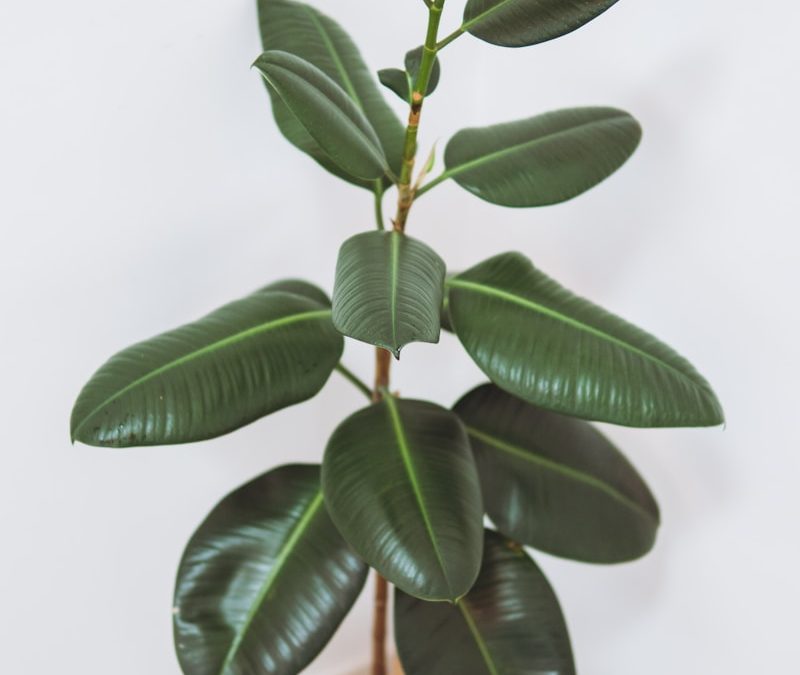Contents
- 1 Rubber Plant Care Indoors (Beginner’s Guide)
- 2 Why Choose a Rubber Plant?
- 3 Light Requirements
- 4 Watering Needs
- 5 Soil and Potting
- 6 Humidity and Temperature
- 7 Feeding Your Rubber Plant
- 8 Pruning and Maintenance
- 9 Common Rubber Plant Problems
- 10 Propagating Rubber Plants
- 11 FAQs About Rubber Plant Care
- 12 Final Thoughts on Rubber Plant Care Indoors
- 13 Related Articles
Rubber Plant Care Indoors (Beginner’s Guide)
Rubber plant care indoors is simple when you know the basics. The Rubber Plant (Ficus elastica) is a striking and low-maintenance houseplant that makes a bold statement in any home. With its large, glossy leaves and forgiving nature, it’s perfect for both beginners and experienced plant owners. This guide will teach you everything you need to know to keep your rubber plant thriving indoors.
Why Choose a Rubber Plant?
- Air-purifying qualities: Helps remove toxins from indoor air.
- Low-maintenance: Tolerates a range of conditions.
- Decorative: Bold, shiny leaves add modern style to interiors.
- Longevity: With proper care, rubber plants can live for many years.
Light Requirements
Proper rubber plant care indoors begins with the right lighting. Rubber plants prefer bright, indirect light but can tolerate medium light levels. Growth will be slower in low light, and direct sunlight can scorch the leaves.
If your home lacks natural light, try this full-spectrum LED grow light for houseplants.
Watering Needs
- Water when the top 1–2 inches of soil are dry.
- Always use room-temperature water to avoid shocking roots.
- Reduce watering in winter when growth slows.
A soil moisture meter can help prevent overwatering issues common in rubber plant care indoors.
Soil and Potting
- Use a well-draining potting mix, ideally peat-based with perlite or sand.
- Ensure the pot has drainage holes to avoid root rot.
- Repot every 1–2 years when roots begin to circle the pot.
Humidity and Temperature
- Thrives in average to high humidity.
- Mist leaves occasionally in dry air.
- Ideal temperature: 15–26°C (60–80°F).
- Keep away from heating vents or cold drafts.
Feeding Your Rubber Plant
- Fertilize every 4 weeks in spring and summer with a balanced liquid fertilizer.
- Reduce feeding in autumn and winter.
This indoor plant liquid fertilizer is perfect for ficus and tropical plants.
Pruning and Maintenance
- Prune to control size and encourage branching.
- Remove yellow or damaged leaves.
- Wipe leaves with a damp cloth to keep them shiny and dust-free.
Common Rubber Plant Problems
Even with the best rubber plant care indoors, issues can arise:
- Yellow leaves: Overwatering or poor drainage.
- Drooping leaves: Underwatering, low light, or sudden temperature change.
- Brown leaf edges: Low humidity or inconsistent watering.
- Leaf drop: Stress from relocation or drafts.
- Pests: Watch for spider mites, scale, or mealybugs.
Tip: Inspect your plant weekly to catch problems early.
Propagating Rubber Plants
Rubber plants are easy to propagate with stem cuttings:
- Take a cutting with at least one node.
- Dip the end in rooting hormone for better success.
- Place in water or moist soil.
- Keep warm and humid until roots develop.
FAQs About Rubber Plant Care
Q: How big can a rubber plant grow indoors?
A: Indoors, they can reach 6–10 feet tall, depending on the pot size and conditions.
Q: Do rubber plants clean the air?
A: Yes, they remove toxins like formaldehyde and improve air quality.
Q: Can rubber plants tolerate low light?
A: They survive in low light but thrive best in bright, indirect light.
Q: How often should I repot a rubber plant?
A: Every 1–2 years or when roots outgrow the pot.
Final Thoughts on Rubber Plant Care Indoors
Rubber plant care indoors is straightforward and rewarding. By providing bright indirect light, moderate watering, and occasional feeding, your Ficus elastica can grow into a stunning centerpiece. Regular pruning, dusting, and attention to humidity will keep it looking lush and healthy for years. Whether you’re a beginner or a seasoned plant owner, the rubber plant is one of the easiest houseplants to enjoy long-term.
Learn more about rubber plant care from the RHS Ficus elastica guide.

